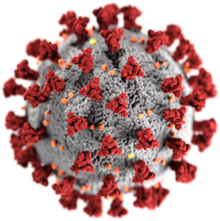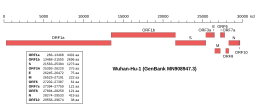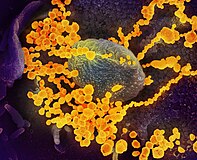កូរ៉ូណាវីរុសសមាការផ្លូវដង្ហើមស្រួចស្រាវធ្ងន់ធ្ងរ២
| កូរ៉ូណាវីរុសសមាការផ្លូវដង្ហើមស្រួចស្រាវធ្ងន់ធ្ងរ២ | |
|---|---|

| |
| អតិសុខុមរូបភាពអេឡិចត្រុងបេសកម្មនៃវីរ្យ៉ុងសារស៍-កូវ-២ ដែលមានពួកកូរ៉ូណាដែលអាចមើលឃើញ | |

| |
| រូបាធិប្បាយនៃវីរ្យ៉ុងសារស៍-កូវ-២ | |
| ចំណាត់ថ្នាក់វិសាណូ | |
| (អឋានន្តរ): | វិសាណូ |
| ចក្រ: | រីបូវីរ្យ៉ា |
| Phylum: | អាំងសឺទែសេឌីស |
| លំដាប់: | នីដូវីរ៉ាលេស |
| អំបូរ: | កូរ៉ូណាវីរីឌែ |
| លំដាប់រង: | កូរ៉ូណាវិសាណូទាក់ទងនឹងសមាការផ្លូវដង្ហើមស្រួចស្រាវធ្ងន់ធ្ងរ |
| ប្រភេទ: | |
| ពូជ: | កូរ៉ូណាវីរុសសមាការផ្លូវដង្ហើមស្រួចស្រាវធ្ងន់ធ្ងរ២
|
| សមនាម | |
|
២០១៩-នកូវ Hកូវ-១៩[១] | |
កូរ៉ូណាវីរុសសមាការផ្លូវដង្ហើមស្រួចស្រាវធ្ងន់ធ្ងរ២ (សារស៍-កូវ-២) [២][៣] ពីមុនគេស្គាល់តាមឈ្មោះបណ្ដោះអាសន្នថា នព្វកូរ៉ូណា២០១៩ (នកូវ-២០១៩ រឺ 2019-nCoV) [៤][៥][៦] គឺជាវីរុសអា.រ.ន. (អាស៊ីតរីបូនុយក្លេអ៊ិក រឺ អាស៊ីតរីបូណ្វៃយ៉ូ) ដែលមានច្រវាក់ទោលចំលងវិជ្ជមាន។[៧][៨] វាឆ្លងចូលក្នុងខ្លួនមនុស្ស ហើយក៏បណ្ដាលឱ្យមានជំងឺរាតត្បាតជាសកលដែលកំពុងតែកើតឡើង កូរ៉ូណាវីរុស២០១៩ (កូវីដ-១៩) ត្រូវបានកំណត់ថាជាគ្រោះអាសន្នសុខភាពសាធារណៈដែលជាក្ដីព្រួយបារម្ភរបស់អន្តរជាតិដោយអង្គការសុខភាពពិភពលោក (ហ៊ូ រឺ WHO)។[៩][១០]
សារស៍-កូវ-២មានសមានភាពសែនជិតដិតទៅនឹងពួកកូរ៉ូណាវីរុសប្រចៀវ ដែលប្រហែលមានកំណើតចេញពីសត្វនេះ។[១១][១២][១៣] ស្ពានចំលង (reservoir) សត្វអន្តរករ ដូចជា ពង្រូលក៏ត្រូវបានគេគិតទុកថាបានជាប់ពាក់ព័ន្ធទៅនឹងការចំលងរបស់វាមកកាន់មនុស្សផងដែរ។[១៤][១៥] តាមទិដ្ឋភាពវគ្គីសាស្ត្រ សារស៍-កូវ-២ ត្រូវបានចាត់ថ្នាក់ជាពូជនៃប្រភេទកូរ៉ូណាវីរុសទាក់ទងនឹងសមាការផ្លូវដង្ហើមស្រួចស្រាវធ្ងន់ធ្ងរ (សារស៍រ-កូវ)។[២]
ពីព្រោះតែពូជនេះត្រូវបានគេរកឃើញនៅអ៊ូហាន ប្រទេសចិន ជួនកាលវាត្រូវបានគេចាត់ទុកថាជា វីរុសអ៊ូហាន រឺ កូរ៉ូណាវីរុសអ៊ូហាន[១៦][១៧][១៨][១៩] ទោះបីយ៉ាងណា អង្គការសុខភាពពិភពលោក (WHO) មិនលើកទឹកចិត្តឱ្យប្រើឈ្មោះផ្អែកទៅលើទីកន្លែងនោះទេ។[២០] ដើម្បីចៀសវាងការភាន់ច្រឡំគ្នាជាមួយជំងឺ សារស៍ WHO (ហ៊ូ) ជួនកាល ហៅ វីរុសនេះ ថាជាវីរុសបង្កជាជំងឺកូវីដ-១៩ រឺ វីរុសកូវីដ-១៩ ក្នុងការផ្ដល់ពត៌មានសុខភាពជាសាធារណៈ។[២១] ទាំងវីរុស និង ជំងឺនេះជារឿយៗត្រូវបានហៅថា កូរ៉ូណាវីរុស ដោយសាធារណជនទូទៅ ប៉ុន្តែអ្នកវិទ្យាសាស្ត្រនិងអ្នកសារពត៌មានភាគច្រើនប្រើប្រាស់បច្ចេកសព្ទត្រូវចំៗពាក្យជាង។[២២]
វិសាណូវិទ្យា
[កែប្រែ]ការឆ្លង
[កែប្រែ]ការចំលងសារស៍-កូវ-២ ពីមនុស្សទៅមនុស្ស ត្រូវបានបញ្ជាក់កំឡុងការរាតត្បាតសកលកូរ៉ូណាវីរុស២០១៩-២០។[១០] ការចំលងកើតឡើងដំបូងតាមរយៈតំណក់ទឹកល្អិតតូចៗចេញពីផ្លូវដង្ហើមដោយការក្អក និង កណ្ដាសក្នុងចន្លោះប្រហែល6 feet (1.8 m)។[២៣][២៤] ការប៉ះពាល់ដោយប្រយោលតាមរយៈផ្ទៃដែលមានមេរោគគឺជាករណីការឆ្លងអាចទៅរួចម្យ៉ាងទៀតផងដែរ។[២៥] ការស្រាវជ្រាវជាបឋមបង្ហាញថាវីរុសនេះអាចរស់នៅបានលើប្លាស្ទិក និង ដែកថែបរហូតដល់ទៅបីថ្ងៃ ប៉ុន្តែមិនអាចរស់នៅលើក្រដាសក្រាសរឹង (កាតុង) លើសពីមួយថ្ងៃ រឺក៏ លើស្ពាន់/ទង់ដែងលើសពីបួនម៉ោងឡើយ។[២៦] អា.រ.ន. (ARN រឺ អាន) របស់វីរុសត្រូវបានគេរកឃើញក្នុងសំណាកដែលយកចេញពីអ្នកឆ្លងជំងឺ។[២៧]
យ៉ាងណា វីរុសឆ្លងកំឡុងរយៈកាលដំបូងមិនទាន់ដឹងរយៈពេលច្បាស់លាស់នៅឡើយទេ។[២៨] ថ្ងៃទី១ កុម្ភៈ ២០២០ អង្គការសុខភាពពិភពលោក (WHO) បានបង្ហាញថា ការចំលងពីករណីអរោគសញ្ញាមួយចំនួនហាក់បីដូចជា មិនមែនជាកត្តាជំរុញសំខាន់ឱ្យមានការចំលងទេ។[២៩] ដូច្នេះ ការឆ្លងភាគច្រើនទៅមនុស្សត្រូវបានគេជឿថាបណ្ដាលមកពីការចំលងពីករណីមួយចំនួនដែលចេញរោគសញ្ញានៃជំងឺកូរ៉ូណាវីរុស២០១៩។ យ៉ាងណាក្ដី យកតាមគំរូរោគរាតត្បាតចាប់ផ្ដើមការរីករាលដាលនៅចិនបានណែនាំថាការដាក់អោយនៅដាច់ដោយឡែកពីគ្នាមុនពេលចេញរោគសញ្ញាអាចជាវិធានការណ៍ក្នុងចំណោមការឆ្លងដែលបានចេញជាឯកសារផ្លូវការ។[៣០]
ស្ពានចំលង
[កែប្រែ]ការឆ្លងពីពូជសារស៍-កូវ-២ដែលគេបានដឹងដំបូង ត្រូវបានរកឃើញនៅអ៊ូហាន ប្រទេសចិន។[១១] ប្រភពដើមនៃការចំលងវីរុសទៅកាន់មនុស្ស និងនៅពេលពូជនេះបានប្រែខ្លួនទៅជាភ្នាក់ងារបង្កជំងឺនៅតែមិនច្បាស់។[៣១][៣២][៣៣][៣៤] ការស្រាវជ្រាវអំពីស្ពានចំលងធម្មជាតិនៃពូជវីរុសដែលបានបង្កឱ្យមានការរីករាលដាលជំងឺសារស៍២០០២-២០០៤ ជាលទ្ធផលក្នុងរបកគំហើញក្នុងពួកកូរ៉ូណាវីរុសជ្រឹងដែលដូច-សារស៍ ភាគច្រើនមានដើមកំណើតក្នុង រ៉ៃណូឡូភុស ពួកជ្រឹងក្រចកសេះ ហើយតំណលំដាប់អាស៊ីតនុយក្លេអ៊ិកវីរុសពីរ ត្រូវបានរកឃើញនៅក្នុងសំណាកដែលយកចេញពី រ៉ៃណូឡូភុស ស៊ីនីគុស (ជ្រឹងក្រចកសេះចិនពណ៌លឿងព្រឿង) បង្ហាញនូវលក្ខណៈស្រដៀងគ្នា៨០%ទៅនឹង សារស៍-កូវ-២។[១៣][៣៥][៣៦] តំណលំដាប់អាស៊ីតនុយក្លេអ៊ិកវីរុសទីបីយកចេញពី រ៉ៃណូឡូភុស អាភ្វីនីស ដែលប្រមូលបាននៅខេត្តយូនណានមានលក្ខណៈស្រដៀងគ្នា៩៦%ទៅនឹងសារស៍-កូវ-២។[១១][៣៧] WHO (ហ៊ូ) ចាត់ទុកពួកជ្រឹងជាស្ពានចំលងធម្មជាតិទំនងជាងគេបំផុតរបស់សារស៍-កូវ-២[៣៨] ប៉ុន្តែដោយភាពខុសគ្នារវាងកូរ៉ូណាវីរុសជ្រឹង និង សារស៍-កូវ-២ អញ្ជឹងមនុស្សគប្បីត្រូវបានឆ្លងតាមរយៈធ្មួលអន្តរការណ៍មួយផ្សេងទៀត។[៣៩]
ការសិក្សាមេតាសែណូមបានចុះផ្សាយនៅឆ្នាំ២០១៩ បានឱ្យដឹងជាមុនថា សារស៍-កូវ ដែលជាពូជនៃវីរុស បង្កជំងឺសារស៍ ជាកូរ៉ូណាវីរុសមានរបាយធំទូលាយជាងគេក្នុងចំណោមសំណាកនៃពួកសត្វពង្រូល។[៤០] ថ្ងៃទី៧ កុម្ភៈ ២០២០ គេបានប្រកាសថាពួកអ្នកស្រាវជ្រាវមកពីគ័ងចូវបានរកឃើញសំណាកពង្រូលមួយក្បាលដែលមានតំណលំដាប់អាស៊ីតនុយក្លេអ៊ិកវីរុសមួយ ដូចបេះបិទ ទៅនឹង សារស៍-កូវ-២ ៩៩%។ [៤១] "នៅពេលបានចេញផ្សាយហើយ លទ្ធផលបានបញ្ជាក់ច្បាស់ថា "ដែនប្រូតេអ៊ីន S ភ្ជាប់ធ្មួល នៃពង្រូល-កូវដែលត្រូវបានគេរកឃើញថ្មីៗនេះ ពិតជាដូចគ្នាបេះបិទទៅនឹង ២០១៩-នកូវ ដែលមានភាពខុសគ្នាតែអាស៊ីតអាមីនេមួយទេ។" [៤២] ពួកពង្រូលត្រូវបានការពារក្រោមច្បាប់រដ្ឋការចិន ប៉ុន្តែការបរបាញ់និងជួញដូរខុសច្បាប់ យកពួកវាមកធ្វើជាថ្នាំចិនសែនៅបន្តមានជាធម្មតា។[៤៣]
ពួកអតិសុខុមជីវវិទូ និង ពន្ធុវិទូ នៅតិចសាសបានរកឃើញភស្តុតាងអំពីការផ្ដាច់ចេញវិញដោយឯករាជ្យក្នុងចំណោមពួកកូរ៉ូណាវីរុស ដែលនាំឱ្យមានការលើកឡើងអំពីការជាប់ពាក់ព័ន្ធរបស់ពួកពង្រូលចំពោះដើមកំណើតនៃសារស៍-កូវ-២។[៤៤] យ៉ាងណាមិញ ពួកកូរ៉ូណាវីរុសពង្រូលដែលបានរកឃើញមកទល់ពេលនេះ មានតែសែណូមរួមគ្នាទាំងមូល ៩២% ប៉ុណ្ណោះ ជាមួយនឹងសារស៍-កូវ-២ ដែលវាមិនគ្រប់គ្រាន់ដើម្បីអះអាងថាពួកពង្រូលជាធ្មួលអាស្រ័យអន្តរការណ៍នោះទេ បើប្រៀបធៀបគ្នាទៅនឹង វីរុសសារស៍បង្កឱ្យមានការឆ្លងរីករាលដាលកាលពីឆ្នាំ២០០២-២០០៤ មានសែណូម ៩៩,៨% រួមគ្នាទៅនឹងកូរ៉ូណាវីរុសសំពោចដែលត្រូវបានគេស្គាល់។[៣៩]
សាខាពន្ធុវិទ្យា និង វគ្គីសាស្ត្រ
[កែប្រែ] ការរៀបចំសែណូមនៃការញែកចេញអ៊ូហាន-ហ៊ូ-១ សំណាកតលំដាប់ដំបូងបង្អស់នៃសារស៍-កូវ-២ | |
| ឯ.អ ពន្ធវង្គ ម.ជ.ព.ម.ជី. | MN908947 |
|---|---|
| បរិមាណពន្ធវង្គ | ២៩៩០៣ បាស |
| ឆ្នាំនៃការបំពេញ | ២០២០ |
សារស៍-កូវ-២ ស្ថិតក្នុងអំបូរវីរុសដ៏ធំ ដែលគេស្គាល់ថាពួកកូរ៉ូណាវីរុស។ វាជាវីរុស អា.រ.ន. (ARN) ដែលមានច្រវាក់ទោលចំលងវិជ្ជាមាន (ARNsb+) មួយប្រភេទ។ ពួកកូរ៉ូណាវីរុសផ្សេងទៀតមានសមត្ថភាពបង្កជំងឺជាច្រើនចាប់ពីផ្ដាសាយធម្មតារហូតដល់ជំងឺធ្ងន់ធ្ងរខ្លាំងដូចជាសមាការផ្លូវដង្ហើមដើមបូព៌ា (MERS រឺ ម៉ឺស)។ វាជាកូរ៉ូណាវីរុសដែលគេស្គាល់ទីប្រាំពីរហើយ ដែលបង្ករោគដល់មនុស្សបន្ទាប់ពី ២២៩E, NL៦៣, OC៤៣, HKU១, ម៉ឺស-កូវ និងសារស៍-កូវដើមដំបូងគេ។[៤៥]
ស្រដៀងនឹងពូជកូរ៉ូណាវីរុសទាក់ទងនឹងសារស៍សរឱ្យឃើញក្នុងការរីករាលដាលសារស៍២០០៣ សារស៍-កូវ-២ ក៏ជាសមាជិកនៃពួករង សារបែកូវីរុស (បែតា-កូវ ចំបួរ B)។[៤៦][៤៧][៤៨] តំណលំដាប់ អា.រ.ន. (ARN រឺ អាន) របស់វា មានប្រហែល ៣០០០០ បាសយ៉ាងវែង។[៨] សារស៍-កូវ-២ មានភាពប្លែកខុសគេក្នុងចំណោមពួកបែតាកូរ៉ូណាវីរុសដែលគេបានស្គាល់ នោះត្រង់ការបញ្ចូលត្រង់តំបន់ផ្ដាច់ចេញពហុបាសរបស់វា ជាលក្ខណៈមួយដែលបង្កើននូវសមត្ថភាពបង្ករោគ និង សមត្ថភាពចំលងខុសពីវីរុសដទៃទៀត។[៣៤][៤៩][៥០]
ជាមួយនិងចំនួននៃសែណូមគ្រប់គ្រាន់តជាលំដាប់ វាជាលទ្ធភាពអាចកសាងឡើងវិញនូវមែកធាងសាខាពន្ធុប្រវត្តិមុយតាស្យុងនៃអំបូរវីរុស។ នៅថ្ងៃ១២ មករា ២០២០ សែណូមប្រាំនៃសារស៍-កូវ-២ ត្រូវបានញែកយកចេញពី អ៊ូហាន ដែលត្រូវបានរាយការណ៍ដោយមជ្ឈមណ្ឌលការពារនិងបង្ការជំងឺឆ្លងចិន (CCDC រឺ ម.ក.ជ.ច.) និង ស្ថាប័នដទៃៗទៀត[៨][៥១] ចំនួននៃសែណូមបានកើនឡើងដល់ ៤២ នៅថ្ងៃ៣០ មករា ២០២០។[៥២] ការវិភាគសាខាពន្ធុនៃសំណាកទាំងនោះបានបង្ហាញថាវត្ថុសំណាកជាច្រើន មានជាប់ទាក់ទងយ៉ាងខ្លាំងជាមួយមុយតាស្យុងភាគច្រើនប្រាំពីរ ដែលជាប់ពាក់ព័ន្ធគ្នានឹងបុព្វៈរួម មួយ ដែលសបញ្ជាក់ថាការឆ្លងរបស់មនុស្សដំបូងកើតឡើងនៅខែវិច្ឆិកា រឺ ធ្នូ ២០១៩។[៥២] As of 27 មីនា 2020[update] សែណូមសារស៍-កូវ-២ ចំនួន ១៤៩៥ ដែលបានដកស្រង់ចេញពីប្រាំមួយទ្វីបត្រូវបានគេយកមកប្រើប្រាស់ជាសាធារណៈ។[៥៣]
នៅថ្ងៃ១១ កុម្ភៈ ២០២០ គណៈកម្មការវគ្គីសាស្ត្រវីរុសអន្តរជាតិ (ICTV រឺ គ.វ.វ.អ.) បានប្រកាសអនុលោមតាមវិធានអត្ថិភាពដែលគណនាទំនាក់ទំនងតាមលំដាប់ចំណោមពួកកូរ៉ូណាវីរុសលើមូលភាគនៃតំណលំដាប់រក្សានៃអាស៊ីតនុយក្លេអ៊ិកប្រាំ ភាពខុសគ្នារវាងអ្វីដែលក្រោយមក គេហៅថា ២០១៩-នកូវ និង ពូជវីរុសយកចេញពីការរីករាលដាលសារស៍២០០៣ មិនគ្រប់គ្រាន់ធ្វើឱ្យពួកគេអាចញែកប្រភេទពួកវីរុសទាំងនេះបានឡើយ។ ដូច្នេះ ពួកគេក៏បានកត់សំគាល់ ២០១៩-នកូវ ជាពូជកូរ៉ូណាវីរុសទាក់ទងនឹងសមាការផ្លូវដង្ហើមស្រួចស្រាវធ្ងន់ធ្ងរ។[២]
ជីវវិទ្យាទំរង់
[កែប្រែ]
វីរ្យ៉ុងសារស៍-កូវ-២នីមួយៗមានវិជ្ឈមាត្រប្រហែលពី ៥០–២០០ ណាណូម៉ែត្រ។[៥៤] ដូច ពួកកូរ៉ូណាវីរុសដទៃទៀតដែរ សារស៍-កូវ-២មានប្រូតេអ៊ីនទំរង់បួនយ៉ាង ដែលគេស្គាល់ថាជា S (spike = កណ្ដក), E (envelope = ស្រោម), M (membrane = ភ្នាស) និង N (nucleocapsid = នុយក្លេអូកាប់ស៊ីត ) ប្រូតេអ៊ីន N ផ្ទុកសែណូម អា.រ.ន. (ARN) និងប្រុតេអ៊ីន S, E និង M រួមគ្នាបង្កើតបានជាំស្រោមវីរុស។[៥៥] ប្រូតេអ៊ីនកណ្ដក ដែលត្រូវបានគេបង្កើតជារូបភាពនៅក្នុងកំរិតបរមាណូដោយប្រើប្រាស់អតិសុខុមទស្សនភាពអេឡិចត្រុងគ្រីយ៉ូសែន[៥៦][៥៧] គឺជាប្រូតេអ៊ីនមានតួនាទីឱ្យវីរុសទៅតោងលើភ្នាសនៃកោសិកាធ្មួល។[៥៥]
ការពិសោធគំរូប្រូតេអ៊ីនលើប្រូតេអ៊ីនកណ្ដកនៃវីរុសដែលត្រូវបានគេពន្យល់ភ្លាមៗថាសារស៍-កូវ-២មានសម្ព័ន្ធភាពត្រូវនឹងធ្មួលទទួលអង់ស៊ីមបំលែងជាអង់ស្យូតង់ស៊ីន២ (ACE2) នៃកោសិកាមនុស្សដើម្បីប្រើពួកវាជាយន្តការនៃច្រកចូលកោសិកា។ [៥៨] នៅថ្ងៃ២២ មករា ២០២០ ក្រុមមួយនៅចិនកំពុងធ្វើការជាមួយសែណូមវីរុសពេញលេញ និង ក្រុមមួយនៅសហរដ្ឋប្រើប្រាស់ដោយឯករាជ្យនូវក្បួនពន្ធុវិទ្យាច្រាស និងបានពន្យល់តាមការពិសោធ ថា អង់ស៊ីមបំលែងជាអង់ស្យូតង់ស៊ីន២ (ACE2) អាចដើរតួជាធ្មួលទទួលសារស៍-កូវ-២។[១១][៥៩][៦០][៦១][៦២][៦៣] ការសិក្សាបានបង្ហាញថា សារស៍-កូវ-២ មានសម្ព័ន្ធភាពខ្លាំងទៅនឹង អង់ស៊ីមបំលែងជាអង់ស្យូតូស៊ីន២ (ACE2) របស់មនុស្សជាងពូជវីរុសសារស៍ដើម។[៥៦] សារស៍-កូវ-២ ប្រហែលក៏អាចប្រើប្រាស់បាស៊ីហ្ស៊ីនដើម្បីទទួលបានច្រកចូលកោសិកាផងដែរ។[៦៤]
ប្រូតេអ៊ីនកណ្ដកដើមដែលធ្វើបូរវកម្មដោយប្រូតេអាសតំរាយភ្នាសសេរីន២ (TMPRSS2) ចាំបាច់សំរាប់ជាច្រកចូលនៃសារស៍-កូវ-២។[៦៥] បន្ទាប់ពីវីរ្យ៉ុងរបស់សារស៍-កូវ-២ ភ្ជាប់ទៅនឹងកោសិកាគោលដៅមួយហើយ ប្រូតេអាសរបស់កោសិកា TMPRSS2 វះចំហប្រូតេអ៊ីនកណ្ដកនៃវីរុស បង្ហាញនូវប៉ិបទីតរលាយចូលគ្នាមួយ។ វីរ្យ៉ុងក្រោយមកបានព្រលែង អា.រ.ន. (ARN) ចូលទៅក្នុងកោសិកា បង្ខំឱ្យកោសិកាធ្វើការបន្តពូជឱ្យវីរុសដែលត្រូវបាចសាចទៅចំលងកោសិកាផ្សេងៗបន្ថែមទៀត។[៦៦][non-primary source needed] សារស៍-កូវ-២ បង្កនូវកត្តាសាហ័សយ៉ាងហោចបីដែលជំរុញឱ្យមានការជំរុះវីរ្យ៉ុងថ្មីពីកោសិកាធ្មួល ហើយនិងរារាំងតំណបភាពស៊ាំ។[៥៥]
រោគរាតត្បាតវិទ្យា
[កែប្រែ]
ផ្អែកលើនានាភាពតិចតួចដែលបង្ហាញឱ្យឃើញក្នុងចំណោមតំណលំដាប់សែណូមសារស៍-កូវ-២ដែលគេបានស្គាល់ ពូជនេះគឺត្រូវបានគេគិតថារកឃើញដោយអាជ្ញាធរសុខាភិបាលក្នុងរយៈពេលជាច្រើនសប្ដាហ៍មកហើយនៃការផ្ទុះឡើងក្នុងចំណោមប្រជាជនកាលពីចុងឆ្នាំ២០១៩មកម្ល៉េះ។[៣១][៦៧] ករណីការឆ្លងដំបូងបង្អស់ដែលគេដឹងថ្មីៗនេះគឺត្រូវបានគេគិតថាបានប្រទះឃើញនៅថ្ងៃ១៧ វិច្ឆិកា ២០១៩។[៦៨] វីរុសនេះបានរីករាលដាលជាបន្តបន្ទាប់ទៅគ្រប់ខេត្តទាំងអស់នៃប្រទេសចិន និង ប្រទេសច្រើនជាង ១៥០ ផ្សេងៗទៀតនៅអាស៊ី អឺរ៉ុប អាមេរិកខាងជើង អាមេរិកខាងត្បូង អាភ្វ្រិក និង អូសេអានី។[៦៩] ការចំលងពីមនុស្សម្នាក់ទៅមនុស្សម្នាក់ទៀតដោយវីរុសនេះត្រូវបានគេរកឃើញក្នុងតំបន់អស់ទាំងនេះ។[១០][៧០][៧១][៧២][៧៣][៧៤] នៅថ្ងៃ៣០ មករា ២០២០ សារស៍-កូវ-២ត្រូវបានកំណត់ថាជាភាពអាសន្នសុខភាពសាធារណៈដែលជាក្ដីបារម្ភរបស់អន្តរជាតិ ដោយ ហ៊ូ (WHO)[៩][៧៥] និងនៅថ្ងៃ១១ មីនា ២០២០ ហ៊ូ(WHO) បានប្រកាសវាថាជា រោគរាតត្បាតសកល។[៧៦][៧៧]
គិតត្រឹម ៤ កុម្ភៈ ២០២១ (០:២៣ កូ.ម៉.សក.) មានករណីការឆ្លងត្រូវបានបញ្ជាក់ ១០៤៣៣៣៨៧៨ករណី ដែលក្នុងនោះ ក៏មាននៅប្រទេសចិនផងដែរ។[៦៩] ខណៈពេលនោះ សមាមាត្រនៃការឆ្លងដែលបង្កឱ្យមានករណីឆ្លង រឺ កំណើនជំងឺដែលអាចធ្វើរោគវិនិច្ឆ័យបាននៅតែមិនច្បាស់ [៧៨] គំរូបែបគណិតសាស្ត្រមួយដែលបានប៉ាន់ប្រមាណចំនួនមនុស្សដែលបានឆ្លងនៅអ៊ូហានតែឯងគឺ ៧៥.៨១៥ គិតត្រឹម ២៥ មករា ២០២០ នៅគ្រានោះដែរ ការឆ្លងដែលបានរកឃើញមានទាបជាងតួលេខនេះ។[៧៩] ចំនួនមរណភាពដោយសារវីរុសត្រូវបានគេសន្មតថាមាន ២២៦៥៥៥៩ករណី គិតត្រឹម ៤ កុម្ភៈ ២០២១ (០:២៣ កូ.ម៉.សក.) មនុស្សចំនួន៥៧៩៣៧៤៥៣នាក់បានជាសះស្បើយពីការឆ្លងនាពេលនោះ។[៦៩] ក្រោមមួយភាគបីនៃមរណភាពបានកើតឡើងនៅខេត្តហ៊ូប៉ី ជាទីដែលអ៊ូហានបានស្ថិតនៅ។[៦៩] មុន ២៤ កុម្ភៈ ២០២០ សមាមាត្រនេះកើនលើស ៩៥%។[៨០][៨១]
ចំនួនការបន្តពូជគោល () នៃវីរុសត្រូវបានគេប៉ាន់ប្រមាណថាចន្លោះ ១,៤ និង ៣,៩។[៨២][៨៣] នេះមានន័យថាការឆ្លងដោយសារវីរុសនេះនីមួយៗ ត្រូវបានគេរំពឹងថាបង្កឱ្យមានការឆ្លងថ្មី ១,៤ ដល់ ៣,៩ នៅគ្រាដែលប្រជាជននៃសហគមន៍គ្មានភាពស៊ាំប្រឆាំងនឹងមេរោគ ហើយក៏គ្មានវិធានការបង្ការណាមួយត្រូវបានយកមកប្រើនៅឡើយនោះដែរ។
ឯកសារយោង
[កែប្រែ]- ↑ (19 February 2020)"A distinct new name is needed for the new coronavirus". The Lancet.
- ↑ "Coronavirus disease named Covid-19". BBC News Online. 11 February 2020. https://www.bbc.com/news/world-asia-china-51466362.
- ↑ Surveillance case definitions for human infection with novel coronavirus (nCoV): interim guidance v1, January 2020 (Report). World Health Organization. 2020. WHO/2019-nCoV/Surveillance/v2020.1.
- ↑ "Healthcare Professionals: Frequently Asked Questions and Answers". United States Centers for Disease Control and Prevention (CDC). 11 ខែកុម្ភៈ 2020. Archived from the original on 14 ខែកុម្ភៈ 2020. Retrieved 15 ខែកុម្ភៈ 2020.
{{cite web}}: More than one of|archivedate=and|archive-date=specified (help); More than one of|archiveurl=and|archive-url=specified (help) - ↑ "About Novel Coronavirus (2019-nCoV)". United States Centers for Disease Control and Prevention (CDC). 11 ខែកុម្ភៈ 2020. Archived from the original on 11 ខែកុម្ភៈ 2020. Retrieved 25 ខែកុម្ភៈ 2020.
{{cite web}}: More than one of|archivedate=and|archive-date=specified (help); More than one of|archiveurl=and|archive-url=specified (help) - ↑ "New-type coronavirus causes pneumonia in Wuhan: expert". Xinhua. http://www.xinhuanet.com/english/2020-01/09/c_138690570.htm.
- ↑ ៨,០ ៨,១ ៨,២ "CoV2020". GISAID EpifluDB. Archived from the original on 12 ខែមករា 2020. Retrieved 12 ខែមករា 2020.
- ↑ ៩,០ ៩,១ "W.H.O. Declares Global Emergency as Wuhan Coronavirus Spreads". 30 January 2020. https://www.nytimes.com/2020/01/30/health/coronavirus-world-health-organization.html.
- ↑ ១០,០ ១០,១ ១០,២ (February 2020)"A familial cluster of pneumonia associated with the 2019 novel coronavirus indicating person-to-person transmission: a study of a family cluster". The Lancet 395 (10223): 514–523. DOI:10.1016/S0140-6736(20)30154-9.
- ↑ ១១,០ ១១,១ ១១,២ ១១,៣ (February 2020)"A pneumonia outbreak associated with a new coronavirus of probable bat origin". Nature 579 (7798): 270–273. DOI:10.1038/s41586-020-2012-7.
- ↑ (February 2020)"Another Decade, Another Coronavirus". The New England Journal of Medicine 382 (8): 760–762. DOI:10.1056/NEJMe2001126.
- ↑ ១៣,០ ១៣,១ (April 2020)"The 2019-new coronavirus epidemic: Evidence for virus evolution". Journal of Medical Virology 92 (4): 455–459. DOI:10.1002/jmv.25688.
- ↑ Novel Coronavirus (2019-nCoV): situation report, 22 (Report). World Health Organization. 2020.
- ↑ "Coronavirus: From bats to pangolins, how do viruses reach us?". Deutsche Welle. 7 February 2020. https://www.dw.com/en/coronavirus-from-bats-to-pangolins-how-do-viruses-reach-us/a-52291570.
- ↑ Huang P (22 ខែមករា 2020). "How Does Wuhan Coronavirus Compare with MERS, SARS and the Common Cold?". NPR. Archived from the original on 2 ខែកុម្ភៈ 2020. Retrieved 3 ខែកុម្ភៈ 2020.
- ↑ (2020). "What you need to know about the Wuhan coronavirus". Nature. ISSN 0028-0836. DOI:10.1038/d41586-020-00209-y.
- ↑ "GOP lawmakers continue to use 'Wuhan virus' or 'Chinese coronavirus'". NBC News. https://www.nbcnews.com/news/asian-america/cdc-chief-spurns-term-chinese-coronavirus-used-gop-lawmakers-n1156656.
- ↑ "McCarthy knocks Dems after they claim saying 'Chinese coronavirus' is racist". Fox News. 11 March 2020. https://www.foxnews.com/politics/kevin-mccarthy-pelosi-omar-chinese-coronavirus-racist.
- ↑ World Health Organization best practices for the naming of new human infectious diseases (Report). World Health Organization. 2015. WHO/HSE/FOS/15.1.
- ↑ "Naming the coronavirus disease (COVID-2019) and the virus that causes it". World Health Organization. Retrieved 24 ខែកុម្ភៈ 2020.
From a risk communications perspective, using the name SARS can have unintended consequences in terms of creating unnecessary fear for some populations.... For that reason and others, WHO has begun referring to the virus as "the virus responsible for COVID-19" or "the COVID-19 virus" when communicating with the public. Neither of these designations are [sic] intended as replacements for the official name of the virus as agreed by the ICTV.
- ↑ Harmon A (4 ខែមីនា 2020). "We Spoke to Six Americans with Coronavirus". New York Times. Retrieved 16 ខែមីនា 2020.
- ↑ "How does coronavirus spread?". NBC News. 25 January 2020. https://www.nbcnews.com/health/health-news/how-does-new-coronavirus-spread-n1121856.
- ↑ "How COVID-19 Spreads". U.S. Centers for Disease Control and Prevention (CDC). 27 ខែមករា 2020. Archived from the original on 28 ខែមករា 2020. Retrieved 29 ខែមករា 2020.
- ↑ "Getting your workplace ready for COVID-19" (PDF). World Health Organization. 27 ខែកុម្ភៈ 2020. Retrieved 3 ខែមីនា 2020.
{{cite web}}: CS1 maint: url-status (link) - ↑ (17 March 2020). "Correspondence: Aerosol and Surface Stability of SARS-CoV-2 as Compared with SARS-CoV-1". The New England Journal of Medicine. DOI:10.1056/NEJMc2004973.
- ↑ (March 2020)"First Case of 2019 Novel Coronavirus in the United States". The New England Journal of Medicine 382 (10): 929–936. DOI:10.1056/NEJMoa2001191.
- ↑ (February 2020)"Study claiming new coronavirus can be transmitted by people without symptoms was flawed". Science. DOI:10.1126/science.abb1524.
- ↑ Novel Coronavirus (2019-nCoV): situation report, 12 (Report). World Health Organization. 2020.
- ↑ (16 March 2020)"Substantial undocumented infection facilitates the rapid dissemination of novel coronavirus (SARS-CoV2)". Science: eabb3221. DOI:10.1126/science.abb3221.
- ↑ ៣១,០ ៣១,១ (January 2020)"Wuhan seafood market may not be source of novel virus spreading globally". Science. ISSN 0036-8075. DOI:10.1126/science.abb0611.
- ↑ Eschner K (28 ខែមករា 2020). "We're still not sure where the Wuhan coronavirus really came from". Popular Science. Archived from the original on 29 ខែមករា 2020. Retrieved 30 ខែមករា 2020.
- ↑ (21 February 2020)"Decoding evolution and transmissions of novel pneumonia coronavirus using the whole genomic data". DOI:10.12074/202002.00033.
- ↑ ៣៤,០ ៣៤,១ (17 March 2020)"Correspondence: The proximal origin of SARS-CoV-2". Nature Medicine. DOI:10.1038/s41591-020-0820-9.
- ↑ (15 February 2020)"Bat SARS-like coronavirus isolate bat-SL-CoVZC45, complete genome".
- ↑ (15 February 2020)"Bat SARS-like coronavirus isolate bat-SL-CoVZXC21, complete genome".
- ↑ (10 February 2020)"Bat coronavirus isolate RaTG13, complete genome".
- ↑ (24 February 2020)"Report of the WHO-China Joint Mission on Coronavirus Disease 2019 (COVID-19)".
- ↑ ៣៩,០ ៣៩,១ (26 February 2020)"Mystery deepens over animal source of coronavirus". Nature 579 (7797): 18–19. DOI:10.1038/d41586-020-00548-w.
- ↑ (October 2019)"Viral Metagenomics Revealed Sendai Virus and Coronavirus Infection of Malayan Pangolins (Manis javanica)". Viruses 11 (11): 979. DOI:10.3390/v11110979.
- ↑ (7 February 2020)"Did pangolins spread the China coronavirus to people?". Nature. DOI:10.1038/d41586-020-00364-2.
- ↑ (February 2020)"Isolation and Characterization of 2019-nCoV-like Coronavirus from Malayan Pangolins". bioRxiv. DOI:10.1101/2020.02.17.951335.
- ↑ Kelly, Guy (1 January 2015). "Pangolins: 13 facts about the world's most hunted animal". The Telegraph. https://www.telegraph.co.uk/science/2016/03/15/pangolins-13-facts-about-the-worlds-most-hunted-animal/.
- ↑ (February 2020)"Evidence of recombination in coronaviruses implicating pangolin origins of nCoV-2019". bioRxiv. DOI:10.1101/2020.02.07.939207.
- ↑ (February 2020)"A Novel Coronavirus from Patients with Pneumonia in China, 2019". The New England Journal of Medicine 382 (8): 727–733. DOI:10.1056/NEJMoa2001017.
- ↑ (February 2020)"The continuing 2019-nCoV epidemic threat of novel coronaviruses to global health — The latest 2019 novel coronavirus outbreak in Wuhan, China". International Journal of Infectious Diseases 91: 264–266. DOI:10.1016/j.ijid.2020.01.009.

- ↑ "Phylogeny of SARS-like betacoronaviruses". nextstrain. Archived from the original on 20 ខែមករា 2020. Retrieved 18 ខែមករា 2020.
- ↑ (February 2019)"Global Epidemiology of Bat Coronaviruses". Viruses 11 (2): 174. DOI:10.3390/v11020174.
- ↑ (9 March 2020)"Structure, function and antigenicity of the SARS-CoV-2 spike glycoprotein". Cell. DOI:10.1016/j.cell.2020.02.058.
- ↑ (February 2020)"The spike glycoprotein of the new coronavirus 2019-nCoV contains a furin-like cleavage site absent in CoV of the same clade". Antiviral Research 176: 104742. DOI:10.1016/j.antiviral.2020.104742.
- ↑ "Initial genome release of novel coronavirus". Virological. 11 ខែមករា 2020. Archived from the original on 12 ខែមករា 2020. Retrieved 12 ខែមករា 2020.
- ↑ ៥២,០ ៥២,១ Bedford T, Neher R, Hadfield N, et al. "Genomic analysis of nCoV spread: Situation report 2020-01-30". nextstrain.org. Retrieved 18 ខែមីនា 2020.
- ↑ Cite error: Invalid
<ref>tag; no text was provided for refs namedNextstrainMarch - ↑ (15 February 2020)"Epidemiological and clinical characteristics of 99 cases of 2019 novel coronavirus pneumonia in Wuhan, China: a descriptive study". The Lancet 395 (10223): 507–513. DOI:10.1016/S0140-6736(20)30211-7.
- ↑ ៥៥,០ ៥៥,១ ៥៥,២ (February 2020)"Analysis of therapeutic targets for SARS-CoV-2 and discovery of potential drugs by computational methods". Acta Pharmaceutica Sinica B. DOI:10.1016/j.apsb.2020.02.008.
- ↑ ៥៦,០ ៥៦,១ (February 2020)"Cryo-EM structure of the 2019-nCoV spike in the prefusion conformation". Science 367 (6483): 1260–1263. DOI:10.1126/science.abb2507.
- ↑ Mandelbaum RF (19 ខែកុម្ភៈ 2020). "Scientists Create Atomic-Level Image of the New Coronavirus's Potential Achilles Heel". Gizmodo. Retrieved 13 ខែមីនា 2020.
- ↑ (March 2020)"Evolution of the novel coronavirus from the ongoing Wuhan outbreak and modeling of its spike protein for risk of human transmission". Science China Life Sciences 63 (3): 457–460. DOI:10.1007/s11427-020-1637-5.
- ↑ (January 2020)"Functional assessment of cell entry and receptor usage for lineage B β-coronaviruses, including 2019-nCoV". bioRxiv. DOI:10.1101/2020.01.22.915660.
- ↑ (February 2020)"Functional assessment of cell entry and receptor usage for SARS-CoV-2 and other lineage B betacoronaviruses". Nature Microbiology. DOI:10.1038/s41564-020-0688-y.
- ↑ "Genomic Characterization of the 2019 Novel Coronavirus". The New England Journal of Medicine.
- ↑ (January 2020)"Return of the Coronavirus: 2019-nCoV". Viruses 12 (2): 135. DOI:10.3390/v12020135.
- ↑ (February 2020)"Genomic characterisation and epidemiology of 2019 novel coronavirus: implications for virus origins and receptor binding". The Lancet 395 (10224): 565–574. DOI:10.1016/S0140-6736(20)30251-8.
- ↑ (2020). "SARS-CoV-2 invades host cells via a novel route: CD147-spike protein". bioRxiv. DOI:10.1101/2020.03.14.988345.
- ↑ (16 April 2020)"SARS-CoV-2 Cell Entry Depends on ACE2 and TMPRSS2 and Is Blocked by a Clinically Proven Protease Inhibitor". Cell 181: 1–10. DOI:10.1016/j.cell.2020.02.052.
- ↑ "Anatomy of a Killer: Understanding SARS-CoV-2 and the drugs that might lessen its power". The Economist. 12 ខែមីនា 2020. Retrieved 14 ខែមីនា 2020.
- ↑ Oberholzer M, Febbo P (19 ខែកុម្ភៈ 2020). "What We Know Today about Coronavirus SARS-CoV-2 and Where Do We Go from Here". Genetic Engineering and Biotechnology News. Retrieved 13 ខែមីនា 2020.
- ↑ "Coronavirus: China's first confirmed Covid-19 case traced back to November 17". 13 March 2020. https://www.scmp.com/news/china/society/article/3074991/coronavirus-chinas-first-confirmed-covid-19-case-traced-back.
- ↑ ៦៩,០ ៦៩,១ ៦៩,២ ៦៩,៣ "COVID-19 Dashboard by the Center for Systems Science and Engineering (CSSE) at Johns Hopkins University (JHU)". ArcGIS. Johns Hopkins University. Retrieved 23 ខែមេសា 2020.
- ↑ (March 2020)"Transmission of 2019-nCoV Infection from an Asymptomatic Contact in Germany". The New England Journal of Medicine 382 (10): 970–971. DOI:10.1056/NEJMc2001468.
- ↑ (30 January 2020)"The Coronavirus Is Now Infecting More People Outside China". Wired.
- ↑ "Coronavirus: Singapore reports first cases of local transmission; 4 out of 6 new cases did not travel to China". The Straits Times. 4 February 2020. https://www.straitstimes.com/singapore/coronavirus-spore-reports-first-cases-of-local-transmission-4-out-of-6-new-cases-did-not.
- ↑ "Ecuador confirms five new cases of coronavirus, all close to initial patient". Reuters. 2 March 2020. https://www.reuters.com/article/us-china-health-ecuador/ecuador-confirms-five-new-cases-of-coronavirus-all-close-to-initial-patient-idUSKBN20O2EE.
- ↑ "Algeria confirms two more coronavirus cases". Reuters. 2 March 2020. https://www.reuters.com/article/us-health-coronavirus-algeria/algeria-confirms-two-more-coronavirus-cases-idUSKBN20P00S.
- ↑ "Statement on the second meeting of the International Health Regulations (2005) Emergency Committee regarding the outbreak of novel coronavirus (2019-nCoV)"។ Press release។ 30 January 2020។ https://www.who.int/news-room/detail/30-01-2020-statement-on-the-second-meeting-of-the-international-health-regulations-(2005)-emergency-committee-regarding-the-outbreak-of-novel-coronavirus-(2019-ncov)។ បានយកមក 30 January 2020។
- ↑ "Coronavirus Declared Pandemic by World Health Organization". 11 March 2020. https://www.wsj.com/articles/u-s-coronavirus-cases-top-1-000-11583917794.
- ↑ "WHO Director-General's opening remarks at the media briefing on COVID-19 - 11 March 2020"។ Press release។ 11 March 2020។ https://www.who.int/dg/speeches/detail/who-director-general-s-opening-remarks-at-the-media-briefing-on-covid-19---11-march-2020។ បានយកមក 12 March 2020។
- ↑ "Limited data on coronavirus may be skewing assumptions about severity". STAT. 30 January 2020. https://www.statnews.com/2020/01/30/limited-data-may-skew-assumptions-severity-coronavirus-outbreak/.
- ↑ (February 2020)"Nowcasting and forecasting the potential domestic and international spread of the 2019-nCoV outbreak originating in Wuhan, China: a modelling study". The Lancet 395 (10225): 689–697. DOI:10.1016/S0140-6736(20)30260-9.
- ↑ "Coronavirus deaths leap in China as countries struggle to evacuate citizens". The Guardian. 30 January 2020. https://www.theguardian.com/world/2020/jan/30/coronavirus-deaths-leap-in-china-as-countries-struggle-to-evacuate-citizens.
- ↑ "Coronavirus: China to repay Africa in safeguarding public health". The Sun. 25 February 2020. https://www.sunnewsonline.com/coronavirus-china-to-repay-africa-in-safeguarding-public-health/.
- ↑ (January 2020)"Early Transmission Dynamics in Wuhan, China, of Novel Coronavirus-Infected Pneumonia". The New England Journal of Medicine. DOI:10.1056/NEJMoa2001316.
- ↑ (January 2020)"Pattern of early human-to-human transmission of Wuhan 2019 novel coronavirus (2019-nCoV), December 2019 to January 2020". Euro Surveillance 25 (4). DOI:10.2807/1560-7917.ES.2020.25.4.2000058.
- ↑ វចនានុក្រមជីវវិទ្យា អង់គ្លេស-ខ្មែរ របស់ សាកលវិទ្យាល័យភូមិន្ទភ្នំពេញ ដេប៉ាតឺម៉ង់ជីវវិទ្យា ២០១៣ បោះពុម្ពលើកទី៤
- Pages with reference errors
- Pages containing cite templates with deprecated parameters
- CS1 errors: redundant parameter
- CS1 maint: url-status
- អត្ថបទ with short description
- Short description is different from Wikidata
- ប្រើប្រាស់កាលបរិច្ឆេទថ្ងៃ-ខែ-ឆ្នាំ-ពីMarch 2020
- Articles with 'species' microformats
- Taxobox articles possibly missing a taxonbar
- Articles containing potentially dated statements from មីនា 2020
- Articles with invalid date parameter in template
- All articles containing potentially dated statements
- Pages using multiple image with auto scaled images
- All pages needing factual verification
- Wikipedia articles needing factual verificationពីMarch 2020
- អត្ថបទដែលមានបរាមាត្រកាលបរិច្ឆេទអសុពលភាពក្នុងទំព័រគំរូ
- Articles with hatnote templates targeting a nonexistent page



